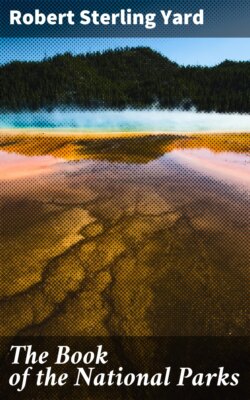Читать книгу The Book of the National Parks - Robert Sterling Yard - Страница 21
На сайте Литреса книга снята с продажи.
II
ОглавлениеThe Yosemite Valley is the heart of the national park. Not only is it the natural entrance and abiding place, the living-room, so to speak, the central point from which all parts of the park are most comfortably accessible; it is also typical in some sense of the Sierra as a whole, and is easily the most beautiful valley in the world.
It is difficult to analyze the quality of the Valley's beauty. There are, as Muir says, "many Yosemites" in the Sierra. The Hetch Hetchy Valley, in the northern part of the park, which bears the same relation to the Tuolumne River that the Yosemite Valley bears to the Merced, is scarcely less in size, richness, and the height and magnificence of its carved walls. Scores of other valleys, similar except for size, abound north and south, which are, scientifically and in Muir's meaning, Yosemites; that is, they are pauses in their rivers' headlong rush, once lakes, dug by rushing waters, squared and polished by succeeding glaciers, chiselled and ornamented by the frosts and rains which preceded and followed the glaciers. Muir is right, for all these are Yosemites; but he is wrong, for there is only one Yosemite.
It is not the giant monoliths that establish the incomparable Valley's world supremacy; Hetch Hetchy, Tehipite, Kings, and others have their giants, too. It is not its towering, perpendicular, serrated walls; the Sierra has elsewhere, too, an overwhelming exhibit of titanic granite carvings. It is not its waterfalls, though these are the highest, by far, in the world, nor its broad, peaceful bottoms, nor its dramatic vistas, nor the cavernous depths of its tortuous tributary canyons. Its secret is selection and combination. Like all supremacy, Yosemite's lies in the inspired proportioning of carefully chosen elements. Herein is its real wonder, for the more carefully one analyzes the beauty of the Yosemite Valley, the more difficult it is to conceive its ensemble the chance of Nature's functioning rather than the master product of supreme artistry.
Entrance to the Yosemite by train is from the west, by automobile from east and west both. From whatever direction, the Valley is the first objective, for the hotels are there. It is the Valley, then, which we must see first. Nature's artistic contrivance is apparent even in the entrance. The train-ride from the main line at Merced is a constant up-valley progress, from a hot, treeless plain to the heart of the great, cool forest. Expectation keeps pace. Changing to automobile at El Portal, one quickly enters the park. A few miles of forest and behold—the Gates of the Valley. El Capitan, huge, glistening, rises upon the left, 3,000 feet above the valley floor. At first sight its bulk almost appalls. Opposite upon the right Cathedral Rocks support the Bridal Veil Fall, shimmering, filmy, a fairy thing. Between them, in the distance, lies the unknown.
Progress up the valley makes constantly for climax. Seen presently broadside on, El Capitan bulks double, at least. Opposite, the valley bellies. Cathedral Rocks and the mediæval towers known as Cathedral Spires, are enclosed in a bay, which culminates in the impressive needle known as Sentinel Rock—all richly Gothic. Meantime the broadened valley, another strong contrast in perfect key, delightfully alternates with forest and meadow, and through it the quiet Merced twists and doubles like a glistening snake. And then we come to the Three Brothers.
Already some notion of preconception has possessed the observer. It could not have been chance which set off the filmy Bridal Veil against El Capitan's bulk; which designed the Gothic climax of Sentinel Rock; which wondrously proportioned the consecutive masses of the Three Brothers; which made El Capitan, now looked back upon against a new background, a new and appropriate creation, a thing of brilliance and beauty instead of bulk, mighty of mass, powerful in shape and poise, yet mysteriously delicate and unreal. As we pass on with rapidly increasing excitement to the supreme climax at the Valley's head, where gather together Glacier Point, Yosemite Falls of unbelievable height and graciousness, the Royal Arches, manifestly a carving, the gulf-like entrances of Tenaya and the Merced Canyons, and above all, and pervading all, the distinguished mysterious personality of Half Dome, presiding priest of this Cathedral of Beauty, again there steals over us the uneasy suspicion of supreme design. How could Nature have happened upon the perfect composition, the flawless technique, the divine inspiration of this masterpiece of more than human art? Is it not, in fact, the master temple of the Master Architect?
